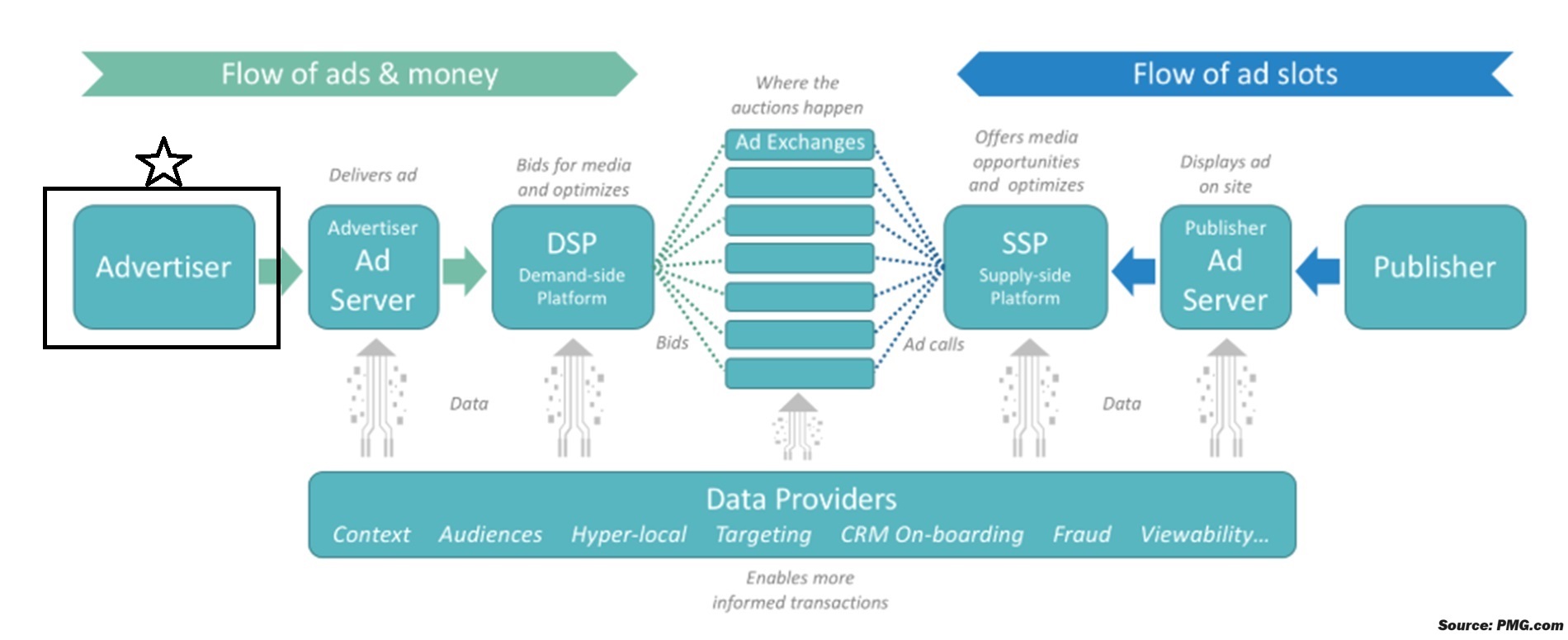Advertisers: The Ad Monetization Ecosystem: Part 2
Advertisers are the driving force behind the digital advertising industry. Their investments fuel the entire ecosystem, from ad servers and demand-side platforms (DSPs) to publishers and supply-side platforms (SSPs). By comprehending the role and strategies of advertisers, stakeholders across the ecosystem can better align their efforts to create more efficient and effective advertising campaigns.
So, the primary goal of this series is to demystify the complex world of advertisers in the digital ad ecosystem. Over the course of several posts, we will delve into various aspects of advertising, offering actionable insights and practical knowledge.

Contents
How Advertisers are Integral to the Ad Ecosystem
Following on “Advertisers: The Ad Monetization Ecosystem: Part 2” post, Advertisers are the cornerstone of the ad ecosystem. They initiate the entire process by investing in ad campaigns to promote their products or services. This investment drives the demand for ad space and fuels the operations of other key players in the ecosystem, such as ad servers, demand-side platforms (DSPs), supply-side platforms (SSPs), and publishers. Without advertisers, there would be no ads to serve, no spaces to sell, and no revenue to generate.
Examples of How Advertisers’ Campaigns Flow Through the Ecosystem
To illustrate the flow of advertisers’ campaigns through the ad ecosystem, let’s consider a simplified example of a programmatic ad campaign:
- Campaign Initiation: A retail brand (the advertiser) wants to launch a new line of shoes. They define their campaign goals, target audience (e.g., young adults aged 18-35), budget, and desired outcomes (e.g., website visits, purchases).
- Using a DSP: The advertiser inputs this information into a DSP. The DSP uses this data to automatically bid on ad spaces that match the advertiser’s criteria across various publishers’ platforms.
- Real-Time Bidding (RTB): The DSP participates in real-time auctions facilitated by SSPs. When a user visits a publisher’s website or app, an ad space becomes available. The SSP offers this space to multiple DSPs, which bid for it on behalf of their advertisers.
- Winning the Bid: The DSP representing the shoe brand wins the bid for an ad space on a popular fashion blog (the publisher). The ad server delivers the shoe brand’s ad to the blog’s website, ensuring it is displayed correctly.
- Ad Delivery and Tracking: The ad server tracks the performance of the ad, collecting data on impressions, clicks, and conversions. This data is sent back to the advertiser, who uses it to measure the effectiveness of their campaign.
- Optimization: Based on the performance data, the advertiser can make adjustments to their campaign, such as refining their target audience or reallocating their budget to more successful ad placements. This iterative process continues, with the DSP and ad server facilitating ongoing optimization.
Common Strategies Used by Advertisers
Advertisers employ a variety of strategies to effectively reach their target audiences and achieve their campaign goals. Some of the most common strategies include:
- Programmatic Buying: Programmatic buying automates the purchasing of digital ad inventory using algorithms and real-time bidding (RTB). This method allows advertisers to efficiently buy ad space across multiple platforms and publishers, ensuring their ads are displayed to the right audience at the right time. Programmatic buying helps optimize ad spend and improves targeting precision.
- Data-Driven Targeting: Leveraging data from various sources, advertisers can create highly targeted campaigns. By analyzing user behavior, preferences, demographics, and other data points, advertisers can segment their audience and deliver personalized ads. This approach increases the relevance of ads, leading to higher engagement and conversion rates.
- Retargeting: Retargeting focuses on users who have previously interacted with a brand but did not convert. By showing these users relevant ads as they browse other sites, advertisers can remind them of the product or service, increasing the likelihood of conversion. Retargeting is particularly effective in moving potential customers further down the sales funnel.
- Content Marketing: Integrating advertising with valuable content can attract and engage audiences. Advertisers create and distribute content that resonates with their target audience, building trust and credibility. This strategy often involves blog posts, videos, infographics, and social media content.
- Influencer Marketing: Collaborating with influencers who have a significant following can amplify a brand’s message. Influencers can provide authentic endorsements and reach niche audiences, driving engagement and conversions.
- Social Media Advertising: Platforms like Facebook, Instagram, Twitter, and LinkedIn offer sophisticated targeting options and a large user base. Advertisers use these platforms to run highly targeted ads, engage with users, and build brand awareness.
- Search Engine Marketing (SEM): SEM involves promoting websites by increasing their visibility in search engine results pages (SERPs) through paid advertising. Google Ads is a popular SEM platform, allowing advertisers to bid on keywords and display ads to users searching for relevant terms.
Tools and Platforms Used by Advertisers
As you probably know, Advertisers leverage a variety of tools and platforms to manage, optimize, and analyze their ad campaigns. Each tool serves a specific function, contributing to the overall effectiveness and efficiency of advertising efforts. Here are the key tools and platforms used by advertisers: As part of our Advertisers: The Ad Monetization Ecosystem: Part 2 post, here are few of the tools Adverisers use >
-
Demand-Side Platforms (DSPs)
- Description: DSPs are automated systems that allow advertisers to purchase digital ad inventory from multiple ad exchanges and networks through a single interface.
- Role: DSPs help advertisers manage their campaigns by automating the bidding process in real-time. Advertisers set their target audience, budget, and campaign goals, and the DSP uses algorithms to bid on ad spaces that match these criteria. This ensures that ads are placed in front of the most relevant audience, optimizing ad spend and improving campaign performance.
-
Ad Networks
- Description: Ad networks aggregate ad inventory from various publishers and sell it to advertisers. They act as intermediaries, offering a wide range of ad formats and placements.
- Role: Ad networks simplify the ad buying process by providing advertisers with access to a large pool of ad inventory. They often offer targeting options based on demographics, interests, and behaviors, allowing advertisers to reach specific segments of their audience. Ad networks also help in scaling campaigns by providing extensive reach across multiple publishers.
-
Ad Servers
- Description: Ad servers are technologies that store, deliver, and track advertisements across different digital platforms.
- Role: Ad servers ensure that ads are displayed correctly and to the intended audience. They track ad performance metrics such as impressions, clicks, and conversions, providing valuable data for optimizing campaigns. Ad servers also manage ad rotation and frequency capping, ensuring that users are not overwhelmed by the same ad repeatedly.
-
Analytics Tools
- Description: Analytics tools, such as Google Analytics and Adobe Analytics, provide detailed insights into user behavior and ad performance.
- Role: These tools help advertisers understand how users interact with their ads and websites. They offer metrics such as traffic sources, user demographics, engagement rates, and conversion paths. By analyzing this data, advertisers can identify areas for improvement, refine their targeting strategies, and optimize their campaigns for better results.
-
Customer Data Platforms (CDPs)
- Description: CDPs are systems that collect, unify, and manage customer data from various sources, providing a comprehensive view of each customer.
- Role: CDPs enable advertisers to create detailed customer profiles and segment their audience more effectively. By integrating data from different touchpoints (e.g., website interactions, email responses, purchase history), CDPs facilitate personalized advertising. This enhances targeting precision and improves the relevance of ads, leading to higher engagement and conversion rates.
-
Ad Exchanges
- Description: Ad exchanges are digital marketplaces where advertisers and publishers buy and sell ad inventory in real-time through automated bidding.
- Role: Ad exchanges provide a transparent and efficient platform for buying and selling ad space. They facilitate real-time bidding (RTB), allowing advertisers to compete for ad placements based on their targeting criteria and budget. This competitive environment helps achieve better ad placement and pricing, maximizing the effectiveness of ad spend.
-
Social Media Advertising Platforms
- Description: Platforms like Facebook Ads, Instagram Ads, Twitter Ads, and LinkedIn Ads offer targeted advertising options on social media networks.
- Role: Social media platforms provide robust targeting capabilities based on user demographics, interests, behaviors, and engagement patterns. Advertisers can create highly tailored campaigns to reach specific audience segments, drive engagement, and achieve various objectives such as brand awareness, lead generation, and sales. The interactive nature of social media also allows for real-time feedback and engagement with users.
-
Search Engine Marketing (SEM) Platforms
- Description: SEM platforms, such as Google Ads and Bing Ads, enable advertisers to display ads on search engine results pages (SERPs).
- Role: SEM platforms use keyword targeting to display ads to users who are actively searching for related products or services. Advertisers bid on relevant keywords, and their ads appear in the search results when users enter those terms. SEM is highly effective for capturing intent-driven traffic and driving conversions. It also provides detailed analytics to measure the performance of keywords and ad copy.
 Challenges Faced by Advertisers
Challenges Faced by Advertisers
Contiuning on Advertisers: The Ad Monetization Ecosystem: Part 2 post, here are some of the challenges Adversitrers face
-
Ad Fraud
- Description: Ad fraud involves fraudulent activities that deliberately misrepresent ad metrics or generate false interactions to siphon off advertising budgets.
- Impact: Ad fraud leads to wasted ad spend, as advertisers pay for impressions, clicks, or conversions that are not from real users. It can significantly distort performance metrics, making it difficult to assess the true effectiveness of campaigns. This ultimately reduces the ROI of advertising efforts.
-
Viewability Issues
- Description: Viewability refers to whether an ad is actually seen by users. Ads that are not viewable do not contribute to campaign goals.
- Impact: Low viewability rates mean that a significant portion of ad spend is ineffective, as ads are not seen by the intended audience. This reduces the potential impact of campaigns and lowers engagement rates, affecting overall ROI.
-
Ad Blockers
- Description: Ad blockers are software tools used by users to prevent ads from being displayed on their devices.
- Impact: The widespread use of ad blockers reduces the reach of digital advertising campaigns, as a substantial number of potential impressions are blocked. This limits the audience that advertisers can reach, diminishing the overall effectiveness and ROI of campaigns.
-
Data Privacy Regulations
- Description: Regulations such as GDPR and CCPA impose strict requirements on how advertisers can collect, store, and use consumer data.
- Impact: Compliance with data privacy regulations can restrict the ability of advertisers to target users effectively. Limited access to user data can reduce the precision of targeting efforts, leading to less personalized and relevant ads, which can lower engagement and conversion rates.
-
Ad Fatigue
- Description: Ad fatigue occurs when users become tired of seeing the same ads repeatedly, leading to decreased engagement.
- Impact: Ad fatigue can result in lower click-through rates (CTR) and engagement levels as users start to ignore or actively avoid ads. This reduces the effectiveness of ad campaigns and negatively impacts ROI.
-
Cross-Device Targeting
- Description: Cross-device targeting involves reaching the same user across multiple devices, such as smartphones, tablets, and desktops.
- Impact: Inconsistent cross-device targeting can lead to fragmented user experiences and ineffective ad delivery. Without accurate cross-device tracking, advertisers may struggle to deliver cohesive and relevant ad experiences, reducing campaign effectiveness and ROI.
-
Attribution Challenges
- Description: Attribution refers to the process of identifying which ads and channels contribute to conversions.
- Impact: Inaccurate attribution can lead to incorrect assessments of campaign performance, causing advertisers to misallocate their budgets. Without proper attribution, it becomes challenging to understand which ads drive the most value, resulting in suboptimal ROI.
The Future of Digital Advertising
Before finishing “Advertisers: The Ad Monetization Ecosystem: Part 2” post, I want to highlight few things about the future of Digital Ads
-
Artificial Intelligence (AI) and Machine Learning
- Trend: AI and machine learning are transforming how ads are targeted, optimized, and measured.
- Impact: These technologies enable more precise targeting by analyzing vast amounts of data to predict user behavior and preferences.
- Example: An online retailer uses AI to recommend products to users based on their browsing and purchase history, resulting in increased sales and customer satisfaction.
-
Augmented Reality (AR) and Virtual Reality (VR)
- Trend: AR and VR provide immersive ad experiences, allowing users to interact with products in a virtual environment.
- Impact: These technologies enhance user engagement and create memorable brand experiences.
- Example: A furniture company uses AR to let users visualize how furniture would look in their home before making a purchase, increasing customer confidence and sales.
-
Voice Search and Smart Speakers
- Trend: The rise of voice search and smart speakers is changing how users search for information and interact with brands.
- Impact: Advertisers need to optimize content for voice search and explore opportunities for voice-activated ads.
- Example: A food delivery service creates voice-activated ads for smart speakers, allowing users to place orders through simple voice commands.
-
Blockchain Technology
- Trend: Blockchain offers transparency and security in ad transactions, addressing issues like ad fraud.
- Impact: Blockchain can enhance trust and accountability in the advertising ecosystem.
- Example: A digital ad platform uses blockchain to verify ad impressions and clicks, ensuring advertisers pay only for genuine interactions.



